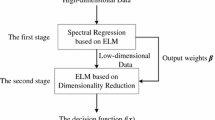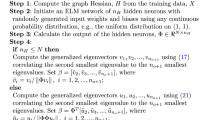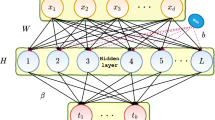Abstract
Extreme learning machine (ELM) works for generalized single-hidden-layer feedforward networks (SLFNs), and its essence is that the hidden layer of SLFNs need not be tuned. But ELM only utilizes labeled data to carry out the supervised learning task. In order to exploit unlabeled data in the ELM model, we first extend the manifold regularization (MR) framework and then demonstrate the relation between the extended MR framework and ELM. Finally, a manifold regularized extreme learning machine is derived from the proposed framework, which maintains the properties of ELM and can be applicable to large-scale learning problems. Experimental results show that the proposed semi-supervised extreme learning machine is the most cost-efficient method. It tends to have better scalability and achieve satisfactory generalization performance at a relatively faster learning speed than traditional semi-supervised learning algorithms.









Similar content being viewed by others
References
Tang X, Han M (2009) Partial Lanczos extreme learning machine for single-output regression problems. Neurocomputing 72(13):3066–3076
Liu Q, He Q, Shi ZZ (2008) Extreme support vector machine classifier. Lect Notes Comput Sci 5012:222–233
Frénay B, Verleysen M (2010) Using SVMs with randomised feature spaces: an extreme learning approach. In: Proceedings of the 18th ESANN, Bruges, Belgium, pp 315–320
Miche Y et al (2010) OP-ELM: optimally pruned extreme learning machine. IEEE Trans Neural Netw 21(1):158–162
Deng W, Zheng Q, Chen L (2009) Regularized extreme learning machine. In: Proceedings of the IEEE symposium on CIDM, pp 389–395
Huang G-B, Zhu Q-Y, Siew C-K (2004) Extreme learning machine: a new learning scheme of feedforward neural networks. In Proceedings of the IJCNN, Budapest, Hungary, vol 2, pp 985–990
Huang G-B, Zhu Q-Y, Siew C-K (2006) Extreme learning machine: theory and applications. Neurocomputing 70(1):489–501
Huang G-B, Chen L, Siew C-K (2006) Universal approximation using incremental constructive feedforward networks with random hidden nodes. IEEE Trans Neural Netw 17(4):879–892
Huang G-B, Chen L (2007) Convex incremental extreme learning machine. Neurocomputing 70(16):3056–3062
Huang G-B, Chen L (2008) Enhanced random search based incremental extreme learning machine. Neurocomputing 71(16):3460–3468
Wang G, Zhao Y, Wang D (2008) A protein secondary structure prediction frame- work based on the extreme learning machine. Neurocomputing 72(1–3):262–268
Lan Y, Soh YC, Huang G-B (2008) Extreme Learning Machine based bacterial protein subcellular localization prediction. In: Proceedings of the IEEE international joint conference on neural networks, IJCNN 2008, Hong Kong, pp 1859–1863
Zhang R, Huang G-B, Sundararajan N, Saratchandran P (2007) Multicategory classification using an extreme learning machine for microarray gene expression cancer diagnosis. IEEE/ACM Trans Comput Biol Bioinform 4(3):485–495
Mohammed AA, Minhas R, Jonathan Wu QM, Sid-Ahmed MA (2011) Human face recognition based on multidimensional PCA and extreme learning machine. Pattern Recognit 44(10–11):2588–2597
Nizar AH, Dong ZY, Wang Y (2008) Power utility nontechnical loss analysis with extreme learning machine method. IEEE Trans Power Syst 23(3):946–955
Decherchi S, Gastaldo P, Dahiya RS, Valle M, Zunino R (2011) Tactile data classification of contact materials using computational intelligence. IEEE Trans Robot 27(3):635–639
Decherchi S, Gastaldo P, Zunino R, Cambria E, Redi J (2013) Circular-ELM for the reduced-reference assessment of perceived image quality. Neurocomputing 102:78–89
Cambria E, Hussain A (2012) Sentic album: content-, concept-, and context-based online personal photo management system. Cogn Comput 4(4):477–496
Kumar MA (2010) An investigation on linear SVM and its variants for text categorization. In: Second international conference on machine learning and computing (ICMLC), pp 27–31
Wang YG, Cao FL, Yuan YB (2011) A study on effectiveness of extreme learning machine. Neurocomputing 74:2483–2490
Cao FL, Liu B, Park DS (2013) Image classification based on effective extreme learning machine. Neurocomputing 102:90–97
Belkin M, Sindhwani V, Niyogi P (2006) Manifold regularization: a geometric framework for learning from labeled and unlabeled examples. J Mach Learn Res 7:2399–2434
Xue H, Chen S, Yang Q (2009) Discriminatively regularized least-squares classification. Pattern Recognit 42(1):93–104
Fan M, Gu N, Qiao H et al (2011) Sparse regularization for semi-supervised classification. Pattern Recognit 44(8):1777–1784
Li Lina, Liu Dayou, Ouyang Jihong (2012) A new regularization classification method based on extreme learning machine in network data. J Inf Comput Sci 9(12):3351–3363
Liu Junfa, Chen Yiqiang, Liu Mingjie et al (2011) SELM: semi-supervised ELM with application in sparse calibrated location estimation. Neurocomputing 74(16):2566–2572
Huang G-B, Zhou HM, Ding XJ (2012) Extreme learning machine for regression and multiclass classification. IEEE Trans Syst Man Cybern Part B Cybern 42(2):513–529
He Xiaofei, Cai Deng, Shao Yuanlong, Bao Hujun, Han Jiawei (2011) Laplacian regularized Gaussian mixture model for data clustering. IEEE Trans Knowl Data Eng 23(9):1406–1418
Huang G-B et al (2011) Extreme learning machines: a survey. Int J Mach Learn Cybern 2:107–122
Hull JJ (1998) A data base for hand written text recognition research. IEEE Trans Pattern Anal Mach Intell 16(5):550–554
Lee KC, Ho J, Kriegman D (2005) Acquiring linear subspaces for face recognition under variable lighting. IEEE Trans Pattern Anal Mach Intell 27(5):684–698
Zhao B, Wang F, Zhang C (2008) CutS3VM: a fast semi-supervised SVM algorithm. In: The 14th ACM SIGKDD international conference on knowledge discovery & data mining (KDD), Las Vegas, NV, USA, pp 830–838
Sindhwani V, Keerthi SS (2006) Large scale semi-supervised linear SVMs. In: 29th Annual international ACM SIGIR. Technical report
Acknowledgments
This work is supported by the National Natural Science Foundation of China, China (No. 61403394) and the Fundamental Research Funds for the Central Universities (No. 2014QNA45).
Author information
Authors and Affiliations
Corresponding authors
Rights and permissions
About this article
Cite this article
Liu, B., Xia, SX., Meng, FR. et al. Manifold regularized extreme learning machine. Neural Comput & Applic 27, 255–269 (2016). https://doi.org/10.1007/s00521-014-1777-8
Received:
Accepted:
Published:
Issue Date:
DOI: https://doi.org/10.1007/s00521-014-1777-8




